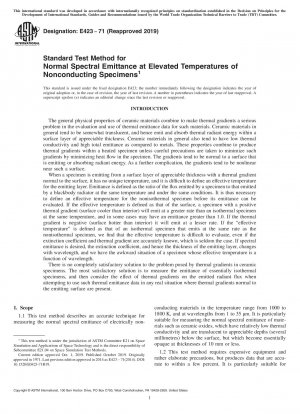ASTM E423-71(2019)
Standard Test Method for Normal Spectral Emittance at Elevated Temperatures of Nonconducting Specimens
- Standard No.
- ASTM E423-71(2019)
- Release Date
- 2019
- Published By
- American Society for Testing and Materials (ASTM)
- Latest
- ASTM E423-71(2019)
- Scope
- 1.1 This test method describes an accurate technique for measuring the normal spectral emittance of electrically nonconducting materials in the temperature range from 1000 to 1800 K, and at wavelengths from 1 to 35 µm. It is particularly suitable for measuring the normal spectral emittance of materials such as ceramic oxides, which have relatively low thermal conductivity and are translucent to appreciable depths (several millimetres) below the surface, but which become essentially opaque at thicknesses of 10 mm or less. 1.2 This test method requires expensive equipment and rather elaborate precautions, but produces data that are accurate to within a few percent. It is particularly suitable for 1 This test method is under the jurisdiction of ASTM Committee E21 on Space Simulation and Applications of Space Technology and is the direct responsibility of Subcommittee E21.04 on Space Simulation Test Methods. Current edition approved Oct. 1, 2019. Published October 2019. Originally approved in 1971. Last previous edition approved in 2014 as E423 – 71(2014). DOI: 10.1520/E0423-71R19. Copyright © ASTM International, 100 Barr Harbor Drive, PO Box C700, West Conshohocken, PA 19428-2959. United States This international standard was developed in accordance with internationally recognized principles on standardization established in the Decision on Principles for the Development of International Standards, Guides and Recommendations issued by the World Trade Organization Technical Barriers to Trade (TBT) Committee. 1 research laboratories, where the highest precision and accuracy are desired, and is not recommended for routine production or acceptance testing. Because of its high accuracy, this test method may be used as a reference method to be applied to production and acceptance testing in case of dispute. 1.3 This test method requires the use of a specific specimen size and configuration, and a specific heating and viewing technique. The design details of the critical specimen furnace are presented in Ref (1),2 and the use of a furnace of this design is necessary to comply with this test method. The transfer optics and spectrophotometer are discussed in general terms. 1.4 The values stated in SI units are to be regarded as standard. No other units of measurement are included in this standard. 1.5 This standard does not purport to address all of the safety concerns, if any, associated with its use. It is the responsibility of the user of this standard to establish appropriate safety, health, and environmental practices and determine the applicability of regulatory limitations prior to use. 1.6 This international standard was developed in accordance with internationally recognized principles on standardization established in the Decision on Principles for the Development of International Standards, Guides and Recommendations issued by the World Trade Organization Technical Barriers to Trade (TBT) Committee.
ASTM E423-71(2019) Referenced Document
- ASTM E349 Standard Terminology Relating to Space Simulation
ASTM E423-71(2019) history
- 2019 ASTM E423-71(2019) Standard Test Method for Normal Spectral Emittance at Elevated Temperatures of Nonconducting Specimens
- 1971 ASTM E423-71(2014) Standard Test Method for Normal Spectral Emittance at Elevated Temperatures of Nonconducting Specimens
- 1971 ASTM E423-71(2008) Standard Test Method for Normal Spectral Emittance at Elevated Temperatures of Nonconducting Specimens
- 1971 ASTM E423-71(2002) Standard Test Method for Normal Spectral Emittance at Elevated Temperatures of Nonconducting Specimens
- 1971 ASTM E423-71(1996)e1 Standard Test Method for Normal Spectral Emittance at Elevated Temperatures of Nonconducting Specimens
